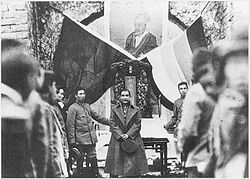Corrective Revolution (Xiaodong)
| Great Revolution to Correct Xiaodong 崇高革命纠正晓东 Chónggāo Gémìng Jiūzhèng Xiǎodōng | |||||||
|---|---|---|---|---|---|---|---|
| Part of Volatile Century, Xiaodongese Civil War | |||||||
 Lu Keqian announces the creation of the Auspicious Republic | |||||||
| |||||||
| Belligerents | |||||||
|
| File:Flag of Xiaodong (1876-1951).png Army of National Salvation | ||||||
| Commanders and leaders | |||||||
|
|
File:Flag of Xiaodong (1876-1951).png Lu Keqian File:Flag of Xiaodong (1876-1951).png Zhou Hongkui | ||||||
| Strength | |||||||
| 1,000 soldiers | 3,000 soldiers | ||||||
| Casualties and losses | |||||||
| 134 killed or executed | 25 killed | ||||||
The Corrective Revolution (Xiaodongese: 革命纠正; Gémìng Jiūzhèng) officially referred to as the Great Revolution to Correct Xiaodong (崇高革命纠正晓东; Chónggāo Gémìng Jiūzhèng Xiǎodōng) and sometimes referred the Jiaxu Revolution (甲戌; Jiǎxū Gémìng) was an armed revolt in the State of Xiaodong that saw the seizure of power by the Xiaodong Regeneration Society and the Army of National Salvation under Lu Keqian which subsequently created the Auspicious Republic of Xiaodong starting the Xiaodongese Civil War.
Between 1927-33 Xiaodong had been in a state of war, first in the Senrian-Xiaodongese War and then seeing its empire crumble in the Min-Xiaodongese War, Tinzan-Xiaodongese War and Narmadi revolt. In March 1933 a group of moderate military officers led the March 8th Coup, installing the Taiyi Emperor and negotiating ceasefires with Senria under pressure from Tuthina, which angered many nationalists within the military who saw such ceasefires as signs of weakness by the new government.
In April 1933 war hero Lu Keqian created the Xiaodong Regeneration Society, a nationalist group of young officers who wished to overthrow the old, aristocratic order of Xiaodong and institute a modern, centralised state based on National Principlism that opposed the State of Xiaodong. In the summer of 1933 the Xiaodong Regeneration Society was able to count in its ranks most members in the military. In late September 1933 Lu's supporters staged a series of armed uprisings across the country simultaneously taking the cities of Rongzhuo, Shenkong and Lukeng. Lu Keqian declared the creation of the Auspicious Republic in Rongzhuo with himself as Grand Marshal of the newly formed Army of National Salvation. The revolution was bloodless in Rongzhuo and Shenkong, but in other cities especially Shenkong there was fighting between revolutionary troops and loyalists.
The Corrective Revolution resulted in the start of the Xiaodongese Civil War as the north declared itself part of the Auspicious Republic whilst the south remained part of the State of Xiaodong. The civil war would eventually result in the victory of the Army for National Salvation with the new regime being socialist, authoritarian and nationalist in its outlook, creating a one-party state whilst instituting progressive social policies and a socialist command economy.
Modern historians have debated whether the Corrective Revolution was a genuine popular uprising or a simple military coup d'état - whilst much of the revolutionary action was undertaken by the military, contemporary reports indicate that the revolution had broad-based popular support from the people. The Corrective Revolution is continued to be celebrated in Xiaodong as the beginning of Xiaodong's period of modernisation, with the 20th September celebrated as a national holiday.
Background
Since the Baiqiao Revolution in 1866 the Heavenly State of Xiaodong had been governed by a semi-constitutional monarchy, which during the 1910's-20's became more militaristic and expansionist. In 1927 the Xiaodongese government launched an invasion of neighbouring Senria starting the Senrian-Xiaodongese War; a year later the Tinzhanese Communist Revolution broke out in the Xiaodongese province of Tinzhan. The Xiaodongese regime began to implement genocidal policies as early as 1926, but increased them during both wars in both occupied Senria and Tinzhan.
By the 1930's Xiaodong was losing both to Senria, which was supported by Tuthina and Tianzhanese communist forces. Wartime austerity, rationing, conscription and increasing governmental repression by the Xiaodongese government led to an evaporation of support of the regime by the general populace whilst high ranking officers in the military became increasingly dissatisfied with the militaristic policies of Xiaodongese leaders such as the Shanrong Emperor, occupied Senria governor Qiu Hanjie and Prime Minister Ren Xillian, who were determined to continue with the war. In a speech to the Legislative Assembly in December 1932, Ren declared that "there will be no compromise with Senrian or Tianzhanese bandits; either they submit themselves as the lesser people's, or face annihilation".
March 8th Coup
Xiaodong Regeneration Society
August Revolution
Insurrection
Planning
March on Rongzhuo
Siege of Lukeng
Declaration of the Auspicious Republic
Aftermath
Reactions
add countries here in alphabetical order